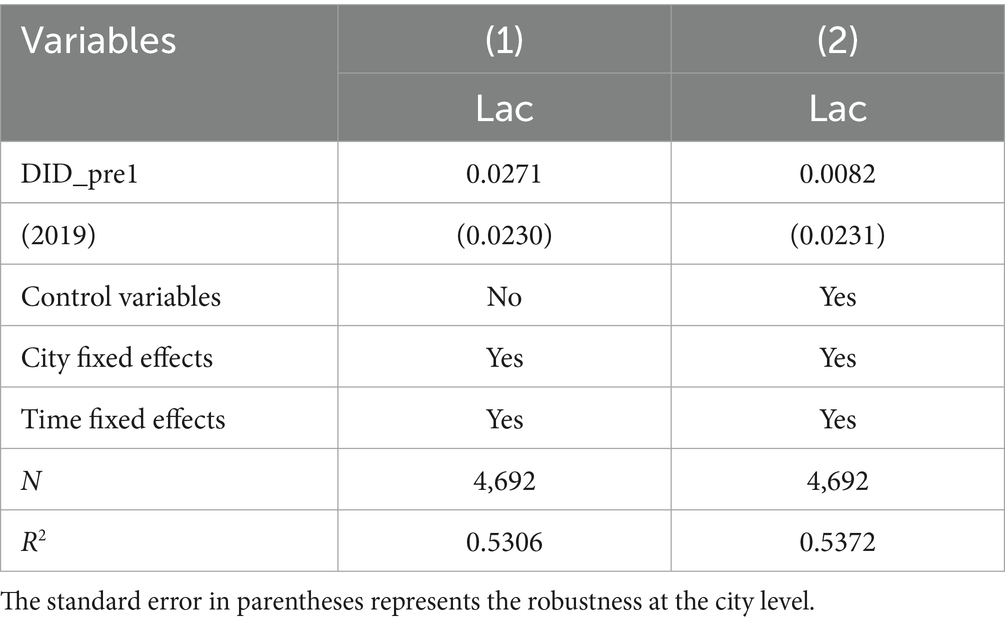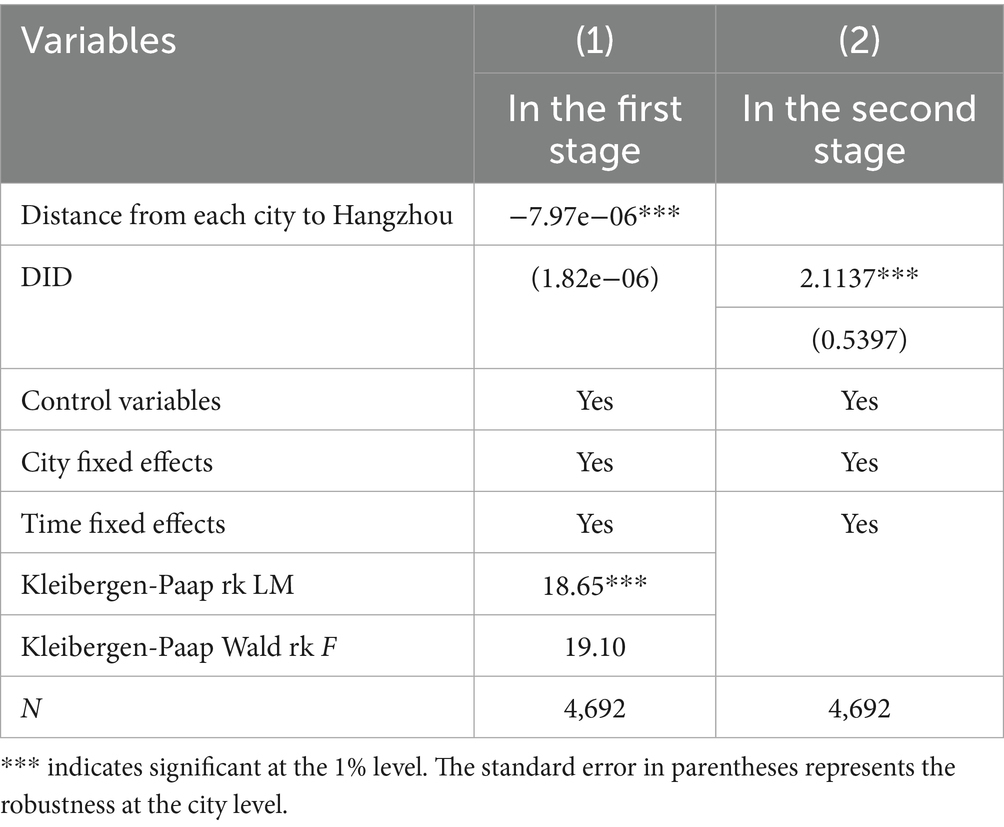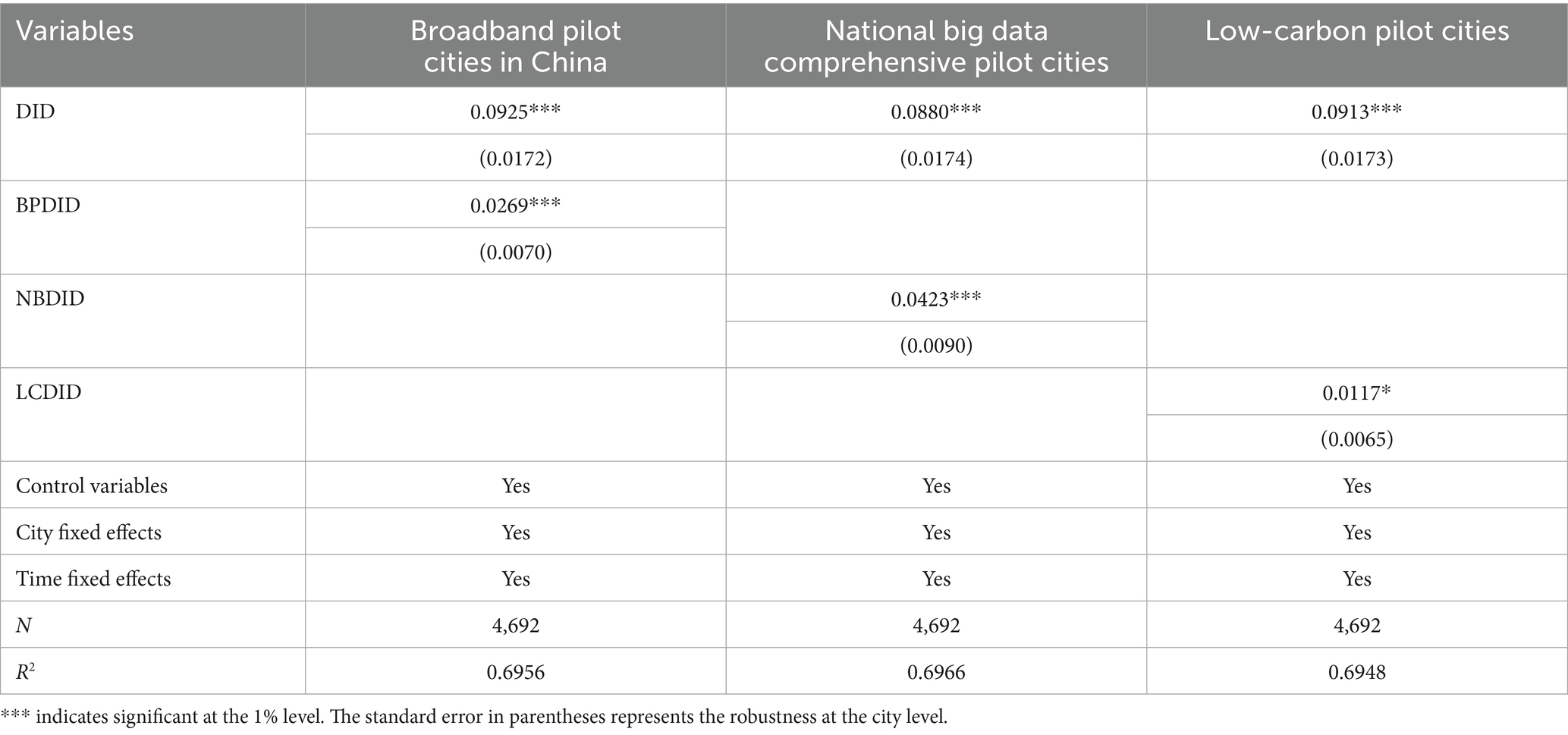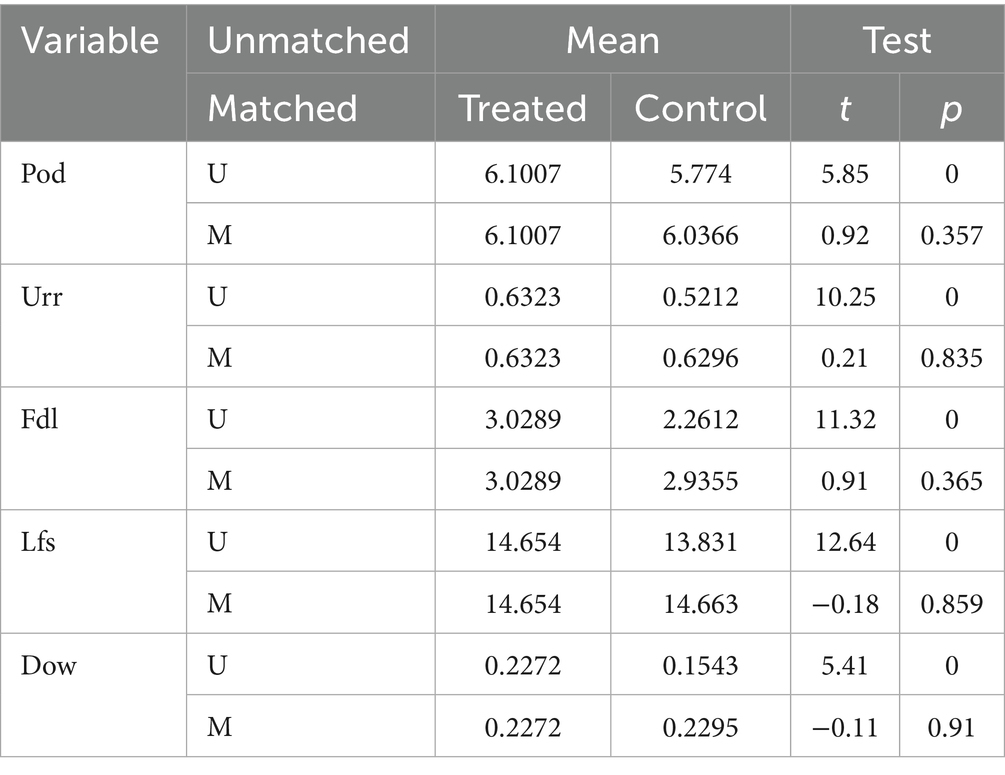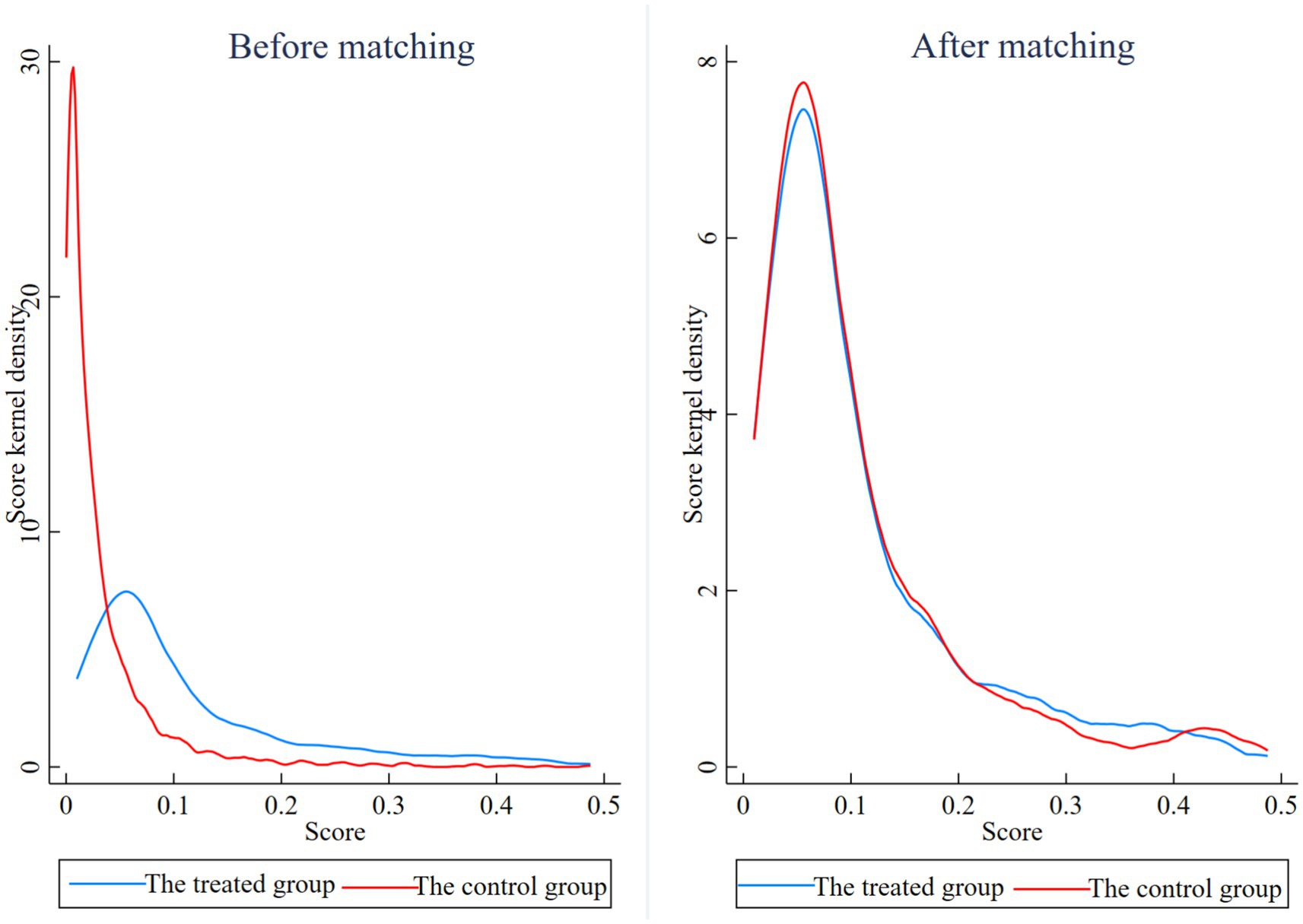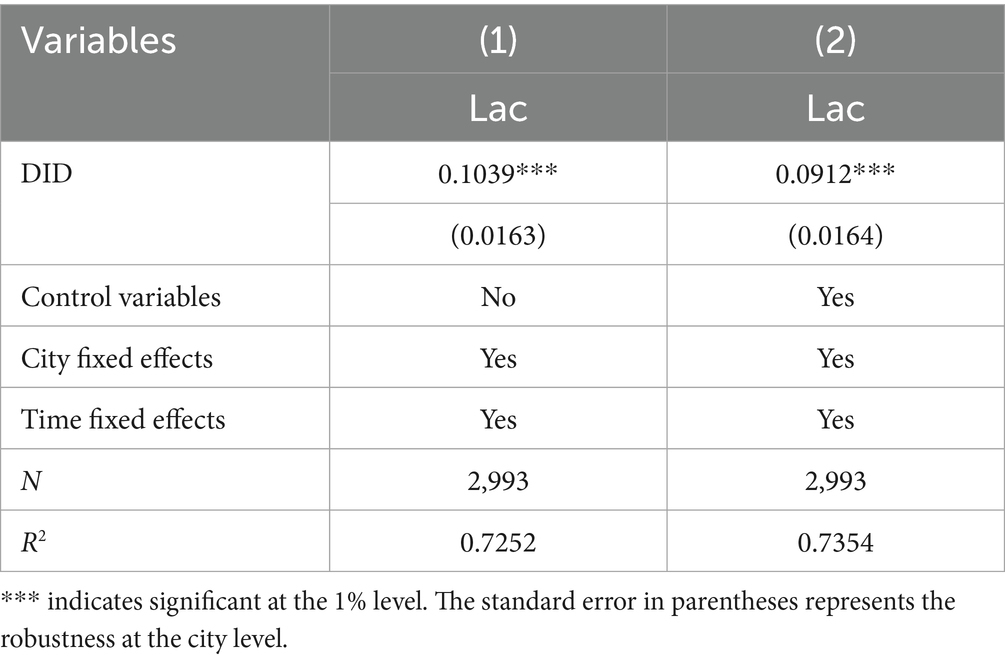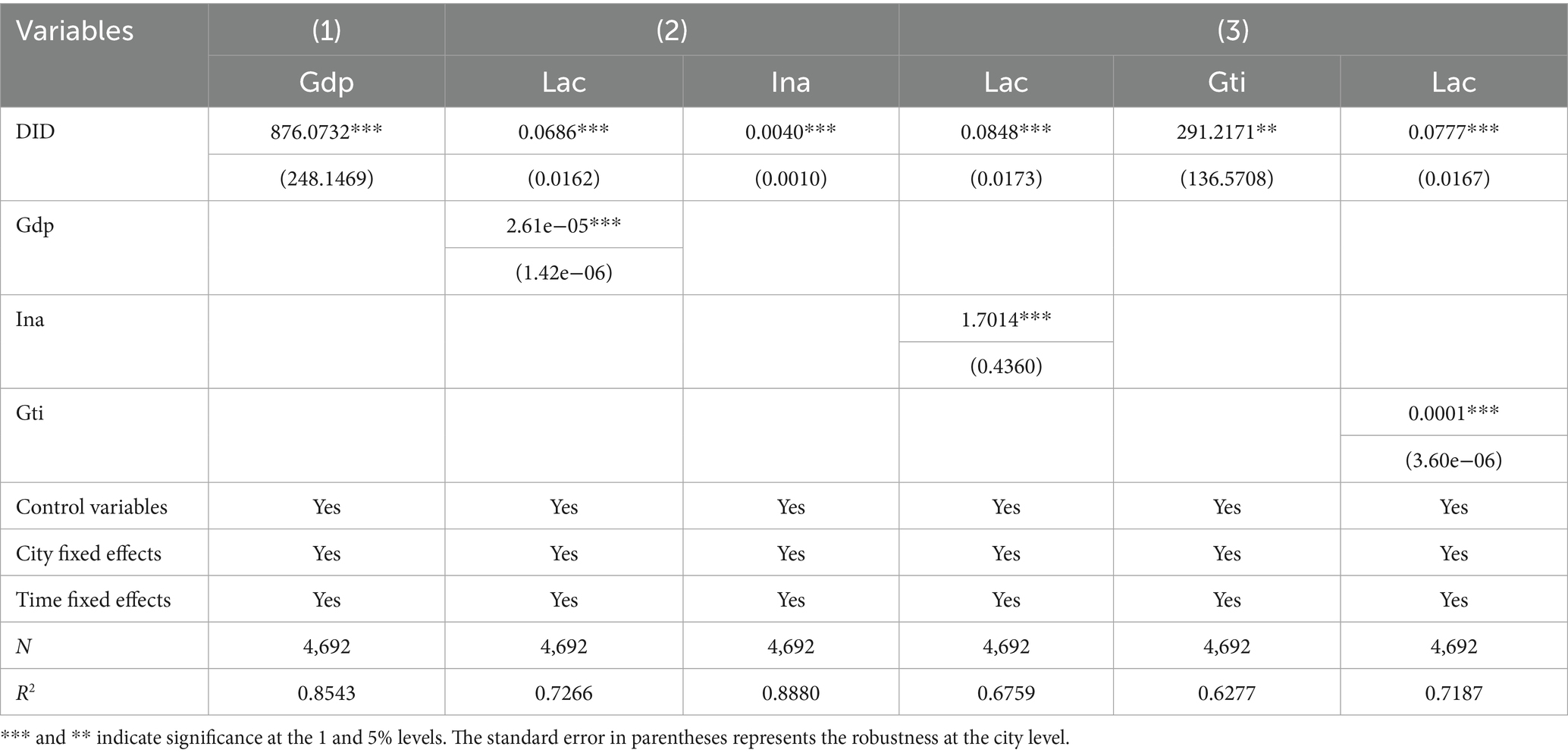- 1School of Economics, Liaoning University, Shenyang, Liaoning, China
- 2Natural Resource Asset Capital Research Center, Hebei GEO University, Shijiazhuang, Hebei, China
This article employs a difference-in-difference model, using panel data from 276 cities spanning the period from 2006 to 2022, to analyze the impact of establishing pilot zones on land allocation efficiency. The research results indicate that: (1) Establishing the pilot zones has a significant positive effect on land allocation efficiency, which is robust to various tests. This not only validates the efficacy of the policy but also suggests its potential for radiating influence, providing a viable model for broader regional implementation. (2) Heterogeneity analysis reveals that the policy’s positive effect on land allocation efficiency is more pronounced in key environmentally protected cities than in non-key cities. Among the regional heterogeneity, the policy effects of northwest cities along the Hu Huanyong Line are the largest, followed by cities along the Hu Huanyong Line, and the policy effects of southeast cities along the Hu Huanyong Line are the smallest. (3) Mechanism testing indicates that pilot zones improve land allocation efficiency by promoting economic growth, industrial agglomeration, and green innovation. This evidence provides policymakers with multidimensional optimization paths.
1 Introduction
Land, as a fundamental resource, is essential for human survival and development. It serves as a spatial foundation for urban construction and industrial activities, thereby driving economic growth. Moreover, land provides the necessary area for agricultural production, which is critical for ensuring food security. Thus, land resources play a vital role in maintaining the stability and advancement of human society. However, issues such as excessive administrative intervention, imperfect market mechanisms, irrational land-use planning, unscientific spatial layouts, and obstacles to the efficient transfer of land resources have hindered the market-based allocation of land, resulting in low urban land-use efficiency (Wu et al., 2011). These inefficiencies not only threaten the protection of farmland and national food security but also increasingly hinder the achievement of a high-quality urban economy (Wang et al., 2015). In light of these challenges, land utilization within the context of urban development and environmental conservation should adhere to the principles of green growth, which offer a viable pathway for enhancing land allocation efficiency (Liang et al., 2019).
In October 2019, the National Development and Reform Commission and the Cyberspace Administration of China jointly formulated and issued the “Implementation Plan for the national digital economy innovation and development pilot zone,” subsequently launching pilot initiatives in several provinces. This policy aims to implement the strategic directives of the Party Central Committee and the State Council regarding the development of the digital economy, to accelerate digital transformation across various sectors of China’s economy and society. Through the adoption of digital technologies, this plan enables the comprehensive collection and integration of land-related data, forming a unified “land resource map” that facilitates dynamic monitoring and supervision. Such a system allows for the timely identification of issues, including idle land and inefficient land utilization. Furthermore, digital platforms help integrate land supply and demand information, breaking down information barriers and enabling both parties to identify matching opportunities more quickly and accurately. This reduces information search and transaction costs, thereby improving the land transfer and allocation efficiency. Therefore, innovation in digital economy policy can enhance land allocation efficiency through the establishment of digital platforms, data-driven evaluation, and full lifecycle supervision.
Research on land allocation efficiency has garnered increasing scholarly attention within the academic community. Grounded in theoretical frameworks such as resource allocation theory and sustainable development theory, the scholarly discourse primarily focuses on two key areas. The first is the measurement of land allocation efficiency, which is of paramount importance for assessing the utilization of resources. Zhang et al. (2020) used a single indicator, dividing the added value of the secondary and tertiary industries by the built-up area, to characterize the efficiency of urban land use. When measuring land use efficiency, Song et al. (2021) and Yang et al. (2021) considered environmental factors such as park green space area or built-up area green coverage, but listed only expected outputs. Later scholars considered both expected and unexpected outputs (Zhu and Gao, 2022; Jia et al., 2024). The second is the influence of factors on land allocation efficiency. Environmental regulations (Xu et al., 2021), new urbanization (Zhang et al., 2022), digital economy (Fan et al., 2023), compact development of urban transportation (Lu et al., 2023), urban expansion, high-speed rail network (Zhang et al., 2023; Zhang et al., 2024), etc., have an impact on land efficiency. In addition, some scholars have also conducted research on the impact of pilot policies such as carbon emission trading (Bian and Zhong, 2023), construction of industrial transformation and upgrading demonstration zones (Zhang and Bian, 2024), and establishment of national financial comprehensive reform pilot zones (Lu et al., 2024) on land efficiency. Inspired by this literature, our research explores a new direction: the effect of the pilot zone initiative on land allocation efficiency. Using the policy’s implementation as a starting point, we investigate how this measure influences land allocation. The digital economy is a structural force reshaping economic development, and related policies are formed as part of the governance system. While widely recognized as pivotal for high-quality development, the role of digital economy policies in optimizing resource allocation has been largely overlooked in prior scholarly work. This study aims to address this critical gap in the literature. Therefore, this article takes the national digital economy innovation and development pilot zone (hereinafter referred to as the pilot zone) as the starting point to study the impact of digital economy policies on land allocation efficiency.
Through the difference-in-difference model, we found that the establishment of the pilot zones has a significant positive impact on land allocation efficiency. Specifically, compared to the control group that did not establish a pilot zone during the same period, the establishment of the pilot zones resulted in a relative improvement of 24.07% in land allocation efficiency. Through heterogeneity analysis, we found that the policy effects of environmental cities are greater than those of non-environmental cities. From the spatial differentiation law of policy effects, the three major regional cities divided by the Hu Huanyong Line show significant gradient differences: cities on the northwest side of the Hu Huanyong Line have the highest policy effects, followed by cities located along the line, while cities on the southeast side of the line have the weakest policy effect intensity, forming an overall spatial distribution pattern of ‘strong in the northwest, medium along the line, and weak in the southeast’. Through mechanism testing, we found that there are three differentiated transmission pathways for the impact of pilot zone establishment on land allocation efficiency. The establishment of the pilot zones is transmitted from the economic level to land allocation efficiency. The establishment of pilot zones relies on industrial agglomeration to enhance land allocation efficiency, and the establishment of these zones also affects land allocation efficiency through green innovation.
Based on the above findings, the marginal contribution of this article lies in three aspects. First, from the perspective of improving land allocation efficiency, it analyzes the beneficial effects of pilot zone policies. It enriches the relevant literature on the effectiveness of policy innovation in the digital economy. The second is to examine the heterogeneity of policy effects by analyzing the influence of two key factors: regional disparities in environmental protection standards and broader socio-economic differences across regions. This analysis reveals how policy outcomes vary under different constraints and conditions, providing valuable empirical insights for refining the construction of the pilot zone. The third is to systematically reveal the inherent mechanism by which the establishment of the pilot zones can affect land allocation efficiency through multiple paths of economic growth, industrial agglomeration, and green innovation. It helps to clarify the transmission path of the impact of the pilot zone policies on land allocation efficiency. It expands the relevant research on the driving factors of land allocation efficiency.
2 Materials and methods
2.1 Policy background
On October 20, 2019, six provinces, including Zhejiang Province, Hebei Province (Xiong’an New Area), Fujian Province, Guangdong Province, Chongqing City, and Sichuan Province, were awarded the title of pilot zones, officially launching the creation of the pilot zones. This policy aims to implement the strategic arrangements of the Party Central Committee and the State Council for advancing the digital economy, with a focus on key areas including the market-based allocation of data elements, the development of digital infrastructure, and innovations in core technologies. By conducting differentiated regional explorations, it aims to overcome development bottlenecks, develop a “Chinese solution” that is replicable and scalable, and thereby provide institutional innovations and reform experience to support the high-quality development of the digital economy. The purpose of establishing the pilot zone is to accelerate the digital transformation of the real economy, integrate resources through the platform economy, reduce transaction costs, promote the reuse of idle resources through the sharing economy, enhance resource utilization, and achieve mutual benefits and win–win outcomes for all parties. Liu (2024) and Zhou and Zhou (2025) have systematically reviewed the policies of the pilot zones. The pilot zone focuses on promoting the “four new” initiatives. The new element is the data element. Activating new elements to break traditional limitations, optimize land resource combinations in innovative ways, improve allocation accuracy, unleash the maximum value of land, and promote efficient economic development. New driving forces are primarily reflected in promoting the deep integration of digital technology and the real economy, as well as fostering and strengthening digital industries, utilizing core technologies such as artificial intelligence and the industrial Internet. Cultivating new driving forces aims to leverage emerging industries and technologies, tap into the diverse potential of land, break the traditional allocation deadlock, enable land resources to adapt efficiently to development needs, and promote economic quality and growth. The core of new governance is to build a diversified collaborative governance system supported by digital technology. Exploring new governance is aimed at reforming land management mechanisms, eliminating obstacles to land resource allocation, enhancing flexibility in resource allocation, aligning land resources with the pace of development, and comprehensively improving allocation efficiency. The core of the new facility is the construction of digital networking. The construction of new facilities promotes the organic integration of different functional lands through optimizing land use layouts, achieving an efficient allocation of land resources in space and function, and promoting regional sustainable development. The establishment of the “four new” construction in the pilot zone can effectively improve land allocation efficiency.
2.2 Research hypothesis
2.2.1 The impact of the establishment of pilot zones on land allocation efficiency
From the core content of pilot zones, it not only builds a high-quality digital economy development ecosystem, but also further promotes the improvement of land allocation efficiency. Firstly, utilizing digital platforms to reconstruct the combination of land resources. In the long run, local governments providing land at low prices distorted land allocation efficiency (Lin et al., 2024). The integration of big data can improve urban land use (Lv et al., 2025). By leveraging new factors, we can break through traditional constraints and utilize innovative approaches to optimize land resource allocation, thereby improving allocation accuracy, unlocking the full potential of land, supporting efficient economic operations, fostering sound alignment between land use and economic development, and enhancing the comprehensive effectiveness of land allocation. Secondly, reduce the idle rate of land and the loss of resource misallocation. Digital technology can enhance the efficiency of farmland use (Zhang, 2025). Digital finance has a positive moderating effect on the impact of economic agglomeration on improving urban land use efficiency (Hu et al., 2024). With the cultivation of new driving forces, the empowerment of digital technology and digital finance enables innovative land management and flexible supply, thereby stimulating the diverse value of this sector. The policy aims to shift land allocation from static planning to dynamic optimization, catalyzing new business models and establishing an intensive, efficient, and innovation-led land-use paradigm to cultivate new economic growth engines. Thirdly, reduce the cost of land allocation. New governance helps cut idle resource costs in land allocation that stem from management hurdles, minimize mismatch losses caused by inflexible allocation, reduce inefficient waste resulting from misalignment between land use and development pace, and eliminate misallocation redundancies under traditional mechanisms—ultimately boosting overall land allocation efficiency. Fourthly, reduce the ineffective losses caused by imbalanced spatial planning. Constructing new facilities to upgrade digitalization levels helps significantly reduce resource waste and operating costs caused by imbalanced spatial layouts, functional fragmentation, and redundant infrastructure construction. It also lowers long-distance commuting needs and logistics inefficiencies, and boosts overall land use synergy. Based on this, the article proposes the following assumptions:
Hypothesis H1: The establishment of the pilot zones can improve land allocation efficiency.
2.2.2 Heterogeneity analysis of the impact of the establishment of the pilot zones on land allocation efficiency
The advancement of the digital economy enables the precise optimization of production processes through technologies such as big data and the Internet of Things, thereby reducing energy consumption and pollution emissions for improved resource utilization. Using the theory of environmental regulation and resource allocation differences, the digital economy is expected to play a significant role in environmental protection (Chen et al., 2023; Arogundade and Hassan, 2025). In key environmental protection cities, the policy of establishing pilot zones places more emphasis on the green and intensive use of land. By leveraging digital technology to strengthen environmental supervision, it is possible to accurately identify and manage inefficient and polluted land, promote the tilt of land towards green industries and ecological projects, and improve land allocation efficiency. In non-environmental key cities, this policy will also promote the development of the digital economy industry and optimize the land use structure. However, it may be relatively weak in terms of coordination between ecological protection and land allocation. However, with the development of the digital economy, non-environmental key cities will gradually attach importance to ecology, consider environmental factors in land allocation, and approach the land allocation model of environmental key cities to achieve coordinated development of economy and environment. China has a vast land area, and the development between regions has its own characteristics, with relative imbalances. Based on the theory of geographical endowment differences and regional imbalanced development, the establishment of pilot zones must consider the differences between various regions (Song and Liu, 2024). Based on this, the article proposes the following assumptions:
Hypothesis H2: The establishment of the pilot zones has heterogeneous impacts on land allocation efficiency in terms of environmental protection level and region.
2.2.3 Analysis of the mechanism of the impact of the establishment of the pilot zones on land allocation efficiency
Emerging as a pivotal force for high-quality development, the digital economy boosts productivity by innovating production models and expands market reach by transcending geographical limitations. At the same time, the digital economy has created new job opportunities and enhanced the quality of the workforce. Under the synergistic effect of multiple aspects, it injects a continuous stream of vitality into high-quality economic development. Scholars have verified that the promotion of high-quality economic development by the digital economy exhibits a non-linear characteristic, with first decreasing marginal effects and then increasing marginal effects (Li et al., 2024), ultimately promoting high-quality economic development (Meng and Guo, 2024). The economic level is crucial for land use (Wang C. et al., 2024) and can have a positive promoting effect on land use efficiency in Chinese urban agglomerations (Zeng et al., 2021). The development of the digital economy can break geographical limitations, making it easier for enterprises to access resources and technology, promoting the concentration of related industries in specific regions, and forming economies of scale. The pilot zone has enabled enterprises in the upstream and downstream industrial chains to achieve some degree of spatial clustering (Guiso et al., 2021). The digital economy enables enterprises to optimize production processes, reduce resource consumption, and gain new competitive advantages for many businesses (Joao et al., 2019). The development of the digital economy can significantly enhance the level of collaborative innovation within the region (Yao and Bai, 2025). Based on this, the article proposes the following assumptions:
Hypothesis H3: The establishment of the pilot zone has an impact on land allocation efficiency through economic level, industrial agglomeration, and green innovation.
In summary, this article presents a theoretical framework for the impact of pilot policies in pilot zones on land allocation efficiency, as illustrated in Figure 1.

Figure 1. Theoretical framework for the impact of pilot zone establishment on land allocation efficiency.
2.3 Variable description
The dependent variable is land allocation efficiency (Lac), which refers to the optimal allocation and utilization of land resources among different uses and users, reflecting the rationality, effectiveness, and sustainability of land use. Referring to the literature by Wang W. et al. (2024), an indicator system is constructed based on input–output analysis, and the output indicators include both expected and unexpected outputs. The input indicators include land, labor, and capital inputs. Land investment encompasses both urban construction land and agricultural land. Labor input encompasses employment in the primary, secondary, and tertiary industries. Capital input includes capital stock. The expected output includes the added value of the primary industry, the added value of the secondary industry, and the added value of the tertiary industry. Unexpected outputs include industrial SO2 emissions and industrial smoke emissions. The measurement method uses the super SBM model, and the larger the measurement result value, the higher the land allocation efficiency.
When measuring the efficiency of decision units using data envelopment analysis (DEA), it only requires a specific relationship between input and output indicators, without prior information about this relationship. When there are a large number of input and output indicators, there will also be a large number of effective decision-making units. The maximum efficiency value obtained by the DEA model is 1, which cannot distinguish the efficiency of these effective decision-making units. The super-efficient SBM model solves this problem. The super efficiency SBM model is an extension of traditional DEA, which allows the efficiency value of effective decision units to exceed the upper limit of 1.
The explanatory variable is the policy of the pilot zone (DID). DID is represented by the interaction term between time dummy variables and pilot city dummy variables. Since the pilot zones were announced in October 2019, the first year of policy effect should be in 2020. That is to say, if the city is included in the pilot program in 2020, its DID value will be 1, indicating the implementation of the pilot zone policy. Otherwise, a value of 0 indicates that the policy of the pilot zone has not been implemented.
The mediating variables are economic level (Gdp), industrial agglomeration (Ina), and green innovation (Gti). The economic level is measured by regional gross domestic product (Li et al., 2019). Industrial agglomeration is measured using location entropy (Yang, 2013). Green innovation is measured by the total number of green patent authorizations.
Referring to the relevant studies of Zhang et al. (2025) and Shi and Xu (2025), the control variables mainly include population density (Pod), urbanization rate (Urr), financial development level (Fdl), local fiscal strength (Lfs), and degree of openness to the outside world (Dow).
2.4 Methods
2.4.1 Double difference model
To examine the impact of establishing pilot zones on land allocation efficiency, this paper constructs a double difference model to evaluate the effects of establishing these zones. The specific model is as follows,
where, represents the city, represents the year. represents land allocation efficiency. indicates whether the policy of the pilot zone has been implemented (1 is yes, 0 is no). represents the set of control variables. represents the number of control variables. represents the kth control variable. represents individual effects. represents time effect. represents the random error term. is the regression coefficient, indicating the degree of impact of the establishment of the pilot zone on land allocation efficiency. is the regression coefficient of the control variable.
2.4.2 Mediation effect model
Drawing on the intermediary relationship and its channel diagram from Jiang (2022), this paper constructs an intermediary effect model to study the mechanism and role of establishing pilot zones in land allocation efficiency, including economic levels, industrial agglomeration, and green technology innovation. The specific model form is as follows,
where, represents the mediating variables, namely economic level, industrial agglomeration, and green technology innovation, while other variables are consistent with model (1).
3 Results
3.1 Data sources and summary statistics
Due to missing data in some cities, the research sample for this article is 276 cities. On August 31, 2006, the State Council issued a notice on strengthening land regulation, adopting stricter management measures, including adjusting interest mechanisms, improving responsibility systems, and other aspects, to effectively strengthen land regulation. Therefore, the time span of this article is from 2006 to 2022. The construction data for national digital economy innovation and development demonstration cities are based on the “Implementation Plan for National Digital Economy Innovation and Development Pilot Zones,” officially issued by the National Development and Reform Commission and the Cyberspace Administration of China in 2019. Other related data mainly come from the “China Urban Statistical Yearbook,” “Statistical Yearbook of Chinese Cities,” and “Statistical Yearbook of Chinese Urban Construction.”
Table 1 presents the descriptive statistical results of the variables. According to Table 1, the average of land allocation efficiency (Lac) is 0.4515. The standard deviation is 0.2052. The minimum and maximum values are 0.1556 and 1.1621, respectively. Land allocation efficiency varies substantially from city to city, a fact that suggests a robust data foundation supports this research.
3.2 Analysis of characteristics of grouping variables
The research sample for this study comprises 276 cities in China, spanning the period from 2006 to 2022. The full sample is divided into two groups based on whether the pilot zone policy was implemented in 2020. One group is the control group, indicating that they did not participate in the pilot zone. In contrast, the other group is the treated group, indicating that they did participate in the pilot zone. The treatment group mainly includes 11 cities in Zhejiang Province (such as Hangzhou City, Ningbo City, and nine others), 10 cities in Fujian Province (such as Fuzhou City, Xiamen City, and eight others), 20 cities in Guangdong Province (such as Guangzhou City, Shenzhen City, and 18 others), 17 cities in Sichuan Province (such as Chengdu City, Zigong City, and 15 others), and the city of Chongqing. The blue-colored section in Figure 2 represents the cities in the treated group.
The data characteristics of the two groups are shown in Figure 3. According to Figure 3, after the establishment of the pilot zones, the box plot of land allocation efficiency in the treatment group is generally higher than that in the control group, indicating that the implementation of the pilot zones has improved the level of land allocation efficiency. This suggests that the implementation of pilot policies in the pilot zones can adjust urban layouts, optimize resource utilization, and prevent waste. From the average before and after the implementation of the pilot policy, the average land allocation efficiency was 0.4079 before implementation and 0.5287 after implementation, representing a 29.62% increase.
3.3 Analysis of main regression results
According to Equation 1, this article presents the main regression results of establishing the pilot zone on land allocation efficiency, as shown in Table 2. Table 2 (1) presents the regression results without the inclusion of any control variables. (2) is the regression result with individual fixed effects. (3) is the regression result with individual fixed effects and time fixed effects. (4) is the regression result with control variables, individual fixed effects, and time fixed effects. Whether with or without controlled variables, the establishment of the pilot zone has a significant positive impact on land allocation efficiency at the 1% level, and hypothesis H1 has been verified. The average efficiency of land allocation is 0.415, and the DID coefficient is 0.099, indicating that the policy effect of the pilot zones on improving land allocation efficiency is 24.07% (0.099/0.415). With the help of the digital economy, it is possible to effectively tap into the potential of land, enable more rational planning and efficient utilization of land resources, promote high-quality regional economic development, and thus facilitate optimized resource allocation and sustainable economic growth.
3.4 Identification effect test
The reliability of the double difference estimation results depends on the assumptions of parallel trends, absence of expected effects, and exclusivity. Only when all these conditions are met, will the results of the main regression be more reliable. To ensure the validity and accuracy of the main regression results, it is necessary to conduct the following tests.
3.4.1 Parallel trend test
The parallel trend assumption requires that in the absence of policy shocks from the pilot zones, the efficiency levels of land allocation in the treated group and control group are similar. To verify this hypothesis, this article constructed a time dummy variable and added it to model (1) to replace DID for regression. The specific model form is as follows:
In Equation 4, represents the dummy variable of pilot cities before and after policy implementation. represents the years before the implementation of the policy. represents the year of policy implementation. represents each year after the implementation of the policy. represents the difference in land allocation efficiency between the treated group and the control group before and after policy implementation. Following the approach of Wang and Ge (2022), the first phase, which occurred before policy implementation, was removed to avoid multicollinearity. Due to the relatively long number of periods before the policy’s implementation, this article sets the period preceding the policy’s implementation as the 11th period. From Figure 4, it can be seen that there was no systematic difference in land allocation efficiency between the treated group and the control group before the implementation of the policy. After the implementation of the policy, the land allocation efficiency of the treated group was significantly higher than that of the control group, and the parallel trend test passed.
3.4.2 Placebo test
To determine whether the establishment of the pilot zone has a positive effect on land allocation efficiency, reduce bias caused by other factors, and isolate the actual policy effect, this article conducts a placebo test. The specific approach is to advance the policy of the pilot zone by 1 year and adopt a random sampling method, randomly selecting the same number of samples from the treated group as from the control group. The estimated coefficient distribution and p-value obtained through 500 Monte Carlo simulations are shown in Figure 5. From Figure 5, it can be seen that the simulated regression coefficients are all smaller than the actual estimated coefficient of 0.0998, and the coefficient distribution is on the left side of this value. Through the p-value test, it can be found that most of the p-values are greater than the 5% level, indicating that most of the regression coefficients are not significant at the 5% level. This indicates that the improvement in land allocation efficiency is attributed to the policies of the pilot zone, rather than to other random factors. The main regression results are unbiased and robust.
3.4.3 Expected effect test
The purpose of the expected effect test in double difference is to examine the potential impact of expected effects on policy effectiveness before the implementation of policies in the pilot zone due to the early release of policy-related information, which may cause relevant entities to adjust their behavior. To ensure the effectiveness and accuracy of the difference-in-difference estimation, unaffected by policy expectations, the expected effects are tested. This article uses the year before policy implementation, 2019, as a false policy implementation time, constructs a new variable DID_pre1, and substitutes it into model (1) to replace the DID in the original model for regression analysis. If the regression results show that the coefficient of DID_pre1 is not significant, it indicates that there is no expected effect in the research context. According to Table 3, regardless of whether control variables are added or not, the coefficient of DID_pre1 is not significant, indicating that there is no expected effect of policies in the pilot zone.
3.4.4 Endogenous test
Model (1) may have endogeneity issues. There are two primary sources of endogeneity problems: one is the problem of random explanatory variables, and the other is the problem of mutual causality. Since the policies of the pilot zones are external shocks, there is no problem with random explanatory variables. Another endogeneity issue is mutual causality. To address reverse causality, following the approach of Fang et al. (2023), the distance from each city to Hangzhou was used as the instrumental variable for DID. The reason the distance between other cities and Hangzhou serves as an instrumental variable lies in its relevance—a key criterion for instrumental variables. Specifically, Alipay, the quintessential birthplace of the digital economy, originates from Hangzhou, which in turn places the city’s digital economy development level among the leaders nationwide. The closer a city is to Hangzhou, the higher its digital economy level will be due to Hangzhou’s influence and the more likely it is to become a pilot zone. In terms of exogeneity, the distance from each city to Hangzhou describes the spatial relationship between a location and other locations, and does not directly affect land allocation efficiency. Therefore, the distance from each city to Hangzhou as an instrumental variable meets the requirements of correlation and exogeneity. The distance from each city to Hangzhou is cross-sectional data and will not change over time. To meet the fixed effects estimation criteria for panel data, instrumental variables for the distance between each city and Hangzhou were constructed by multiplying the distance between each city and Hangzhou by the time trend term.
The estimation results of the two-stage least squares method are shown in Table 4. The Kleiberen Paap Wald rk F-value is greater than the critical value of 16.38 for the 10% significance level of the Stock Logo test, which excludes the distance from each city to Hangzhou as a weak instrumental variable. The p-value of the Kleiberen Paap rk LM statistic is 0, which can reject the hypothesis that the instrumental variable is unidentifiable. In the first stage of regression, the instrumental variable coefficient is highly significant, indicating a strong correlation between instrumental variables and the policies of the pilot zone. The coefficient of the DID regression in the second stage remains positive, with a p-value of 0, indicating that, considering endogeneity, the establishment of pilot zones can significantly improve land allocation efficiency.
3.5 Robustness test
3.5.1 Replacing the dependent variable
This article employs the area of urban construction land (Uca) as a substitute variable for land allocation efficiency for robustness testing. The rationale for this selection is threefold. First, the scale of urban construction land directly reflects the amount of land resources allocated for urban development and, to a certain extent, indicates the intensity of land use. Second, it is closely associated with a city’s economic output and population capacity—generally, a larger construction land area supports more economic activities and a greater population, which indirectly mirrors the efficiency with which land resources underpin urban growth. Finally, data on this indicator are readily accessible and amenable to statistical analysis, offering strong objectivity and comparability. As such, it serves as a practical and effective measure for the preliminary assessment of land allocation efficiency across cities. Using urban construction land area instead of land allocation efficiency for regression analysis, the regression results are shown in Table 5 (1). The DID regression coefficient is significantly positive, consistent with the main regression result, indicating that the main regression result is robust.
3.5.2 Exclusion of special cities
The sample includes four municipalities directly under the central government: Beijing, Tianjin, Shanghai, and Chongqing. These municipalities have developed robust infrastructure and public service systems, as well as abundant and high-quality resources, including education and healthcare. At the same time, they have a high level of economic development, an optimized industrial structure, and thriving high-tech industries, as well as modern service industries. With a large amount of foreign investment and talent, there are more development opportunities. Considering that the four municipalities directly under the central government may influence the estimation results, this study excluded them from the sample and conducted the regression analysis again. The specific results are shown in column (2) of Table 5. The results show that even after excluding four municipalities directly under the central government, the establishment of the pilot zones can still improve land allocation efficiency.
3.5.3 Sample truncation
Extreme values in the sample can interfere with parameter estimation values, leading to model estimation bias. To avoid this issue and ensure the reliability of the estimation results, corresponding processing can be implemented on the sample data to stabilize the model estimation across different data scenarios. The method for handling extreme values in this article is winsorizing, which involves using “nearest substitution” for extreme values in the sample while maintaining the total sample size. The estimated results are shown in Table 5 (3) and (4), where column (3) represents the 3% truncated result and column (4) represents the 10% truncated result. From the results, whether using 3% or 10% tail reduction, the establishment of the pilot zones has a significant positive impact on land allocation efficiency, which once again verifies the robustness of the main regression results.
3.5.4 Excluding the impact of other policies
During the sample period, the central government introduced multiple policies that may affect land allocation efficiency, such as the broadband China pilot program (BPDID), the national big data comprehensive pilot program (NBDID), and the low-carbon city pilot program (LCDID), which may affect the robustness of the main regression results. To mitigate the impact of the broadband China pilot, national big data comprehensive pilot, and low-carbon city pilot, this article incorporates these policies into the regression analysis, and the regression results are presented in Table 6. From Table 6, it can be seen that after the implementation of the broadband China pilot program, the national big data comprehensive pilot program, and the low-carbon city pilot program, the policies of the pilot zones still have a significant positive impact on land allocation efficiency, verifying the robustness of the main regression results.
3.5.5 PSM-DID test
There may be systematic differences between demonstration cities and non-demonstration cities, resulting in incomparability between the treated group and the control group. To mitigate the impact of these systematic differences on the research results, this paper employs propensity score matching (PSM) to select samples randomly. According to the 1:3 nearest neighbor matching method, match control group cities with similar features for each treated group city. The results before and after matching are shown in Table 7; Figure 6. From Table 7, there was a significant difference in the control variables between the treated group and the control group before matching, whereas no significant difference was observed in the control variables between the treated group and the control group after matching. The variable significance test was passed.
From Figure 6, it can be seen that there is a significant difference between the treated group and the control group, although the difference between the two is relatively small. The results of policy effect analysis on the matched sample cities are shown in Table 8. Table 8 (1) shows the results without control variables, while Table 8 (2) shows the results with control variables. Whether with or without control variables, the DID regression coefficients are 0.1039 and 0.0912, respectively, which are close to the main regression results, indicating that the main regression results are robust.
3.5.6 Model form verification
The main regression model adopts a linear form, whereas in practical economic problems, variables often exhibit nonlinear relationships. Using linear regression can result in model setting errors, leading to biased estimates. Dual machine learning can automatically capture the complex, nonlinear relationship between land allocation efficiency and the establishment of pilot zones through flexible, non-parametric methods, thereby avoiding model errors caused by incorrect linear relationships.
Dual machine learning models include partial linear regression models and more general interaction regression models. The form of a partial linear regression model is:
The form of the interactive regression model is:
and represent functions of unknown form that can only be obtained through machine learning models. According to Equations 5–8, this article uses the Lasso machine learning algorithm to estimate the policy coefficient of the pilot zone as the core explanatory variable. The specific results are shown in Table 9. According to Table 9, the 5-fold and 10-fold cross-validation tests of partial linear regression, as well as the 5-fold and 7-fold cross-validation tests of interactive regression, indicate that establishing the pilot zone has a significant positive effect on land allocation efficiency. The values are close to the main regression results, further verifying the robustness of the main regression results.
4 Discussion
4.1 Heterogeneity analysis
4.1.1 Heterogeneity of environmental protection levels
In 2007, the State Council announced the “Eleventh Five-Year Plan for National Environmental Protection,” which identified 113 environmentally friendly cities. Through comprehensive prevention and control of air pollution in 113 key cities, it can prompt adjustments and upgrades to their industrial structures, enhance resource utilization efficiency, foster a positive interaction between economic growth and environmental protection, and facilitate the economy’s transition to a path of sustainable development. The regression results of key environmental protection cities and non-key environmental protection cities are shown in columns (1) and (2) of Table 10. As shown in columns (1) and (2) of Table 10, the establishment of the pilot zone has a significant positive impact on land allocation efficiency.
To compare whether there is a significant difference in policy effects between key environmental protection cities and non-key environmental protection cities, non-key environmental protection cities were used as the basis for comparison. The interaction term between the dummy variables for key environmental protection cities and the DID was added to the main regression model. The estimated coefficient of the interaction term is 0.1244, with a standard error of 0.0307 and a p-value of 0. Indicating that the policy effect of key environmental protection cities is greater than that of non-key environmental protection cities. The reason may be that key environmental protection cities usually have advantages in infrastructure, talent reserves, industrial foundations, and other aspects. These advantages are conducive to the better implementation of policies in the digital economy innovation and development pilot zone, thereby effectively promoting the optimization of land resource allocation and improving land allocation efficiency.
4.1.2 Regional heterogeneity
The Hu Huanyong Line categorizes cities into three groups: southeast cities, cities along the Hu Huanyong Line, and northwest cities, based on their geographical locations. The Hu Huanyong Line mainly guides the rational distribution of industries based on the different resource endowments and population conditions on both sides. The Hu Huanyong Line serves as a crucial basis for formulating regional development policies, prompting the government to fully consider the differences between the eastern and western regions when promoting high-quality economic development. This approach aims to avoid excessive concentration of resources on one side, focus on balanced development, and promote coordinated progress between regions. The regression results of cities in the southeast, along the Hu Huanyong Line, and northwest of the Hu Huanyong Line are shown in Table 10 (3), (4), and (5). According to Table 10 (3), (4), and (5), it can be seen that the establishment of the pilot zones in cities southeast of the Hu Huanyong Line, cities along the Hu Huanyong Line, and cities northwest of the Hu Huanyong Line has a significant positive impact on land allocation efficiency.
To compare whether there are significant differences in policy effects among cities southeast of the Hu Huanyong Line, cities along the Hu Huanyong Line, and cities northwest of the Hu Huanyong Line, with cities northwest of the Hu Huanyong Line as the reference group, the interaction terms of the dummy variables for cities southeast of the Hu Huanyong Line and cities along the Hu Huanyong Line with DID are added to the main regression model for regression analysis. The estimated coefficient of the interaction term between the southeast city of Hu Huanyong Line and DID is −0.1343, with a standard error of 0.0435 and a p-value of 0.002. Compared with cities northwest of the Hu Huanyong Line, its policy effect is 0.1343 units smaller. The estimated coefficient of the interaction term between the southeast city of Hu Huanyong Line and DID is −0.1034, with a standard error of 0.0539 and a p-value of 0.055. Compared with cities northwest of the Hu Huanyong Line, its policy effect is 0.1034 units smaller. The above results indicate that the policy effect is most significant in the northwest cities along the Hu Huanyong Line, followed by the cities along the Hu Huanyong Line, and the policy effect is most negligible in the southeast cities along the Hu Huanyong Line. The reason is that the land resources in the northwest and cities along the Hu Huanyong Line are relatively abundant, but the degree of development and utilization is low. The policy of the pilot zone can bring new technologies and concepts, stimulate land potential, and improve allocation efficiency. However, land development in the southeast cities along the Hu Huanyong Line is mature, and the policy space for implementation is relatively limited.
4.2 Mechanism verification
According to research Hypothesis 3, economic level, industrial agglomeration, and green innovation are the three intrinsic mechanisms through which the establishment of pilot zones affects land allocation efficiency. There are two main dimensions for testing the above mechanism. Dimension one, the impact of the pilot zones on mechanism variables, and dimension two, the impact of mechanism variables on land allocation efficiency. Regarding dimension two, previous studies have empirically tested the significant positive effects of economic level (Yang et al., 2020; Bian, 2024), industrial agglomeration (Yuan et al., 2019; Xue et al., 2023), and green innovation (Chen et al., 2022; Zhang et al., 2023) on land allocation efficiency. According to Equations 2, 3, dimensions one and two were tested, and the test results are shown in Table 11. Table 11 (1) presents the regression results with economic level as the mediating variable, Table 11 (2) presents the regression results with industrial agglomeration level as the mediating variable, and Table 11 (3) presents the regression results with green innovation as the mediating variable. From Table 11 (1) to (3), it can be seen that all regression coefficients are significantly positive, indicating that the establishment of pilot zones can promote economic levels, industrial agglomeration, and green innovation, thereby affecting land allocation efficiency. Hypothesis 3 has been verified.
5 Conclusion and policy implications
5.1 Research conclusion
This article adopts data from 276 prefecture-level cities in China from 2006 to 2022. This study employs the super efficiency SBM model to measure land allocation efficiency. Taking the establishment of the pilot zone as a quasi-natural experiment, it applies a difference-in-difference approach to systematically evaluate the causal effect of this policy on land allocation efficiency. Based on the empirical analysis, the following findings are obtained. First, establishing the pilot zone can improve land allocation efficiency. This conclusion remains robust after a series of identification and robustness testing, confirming the reliability and promotional value of the policy. Second, heterogeneity analysis reveals that the policy effect is more pronounced in key environmentally protected cities than in non-key cities. In terms of regional heterogeneity, the policy impact exhibits a diminishing gradient from the southeastern to the northwestern regions. Third, mechanism testing suggests that establishing pilot zones enhances land allocation efficiency through three pathways: economic level, industrial agglomeration, and green innovation.
5.2 Policy implications
Based on the above conclusions, this article draws the following policy implications.
Firstly, expand the scope of the pilot zone and promote its land allocation mechanism, while establishing a dynamic optimization and regional coordination policy system. One is that the coverage of the pilot zones should be progressively expanded, with successful practices institutionalized and extended to regions with comparable development conditions. This will maximize the potential of land resource allocation optimization on a broader scale. The second is that the land market mechanism should be refined through the introduction of digital management platforms. These platforms can enhance information transparency and transaction efficiency, thereby reducing institutional transaction costs. The third is that a differentiated policy toolbox should be established to allow flexible adaptation of implementation pathways based on regional characteristics. This tailored approach will help avoid the inefficiencies of a one-size-fits-all strategy. The fourth is that cross-regional coordination and feedback mechanisms should be strengthened to facilitate the transfer of land-use indicators and promote benefit sharing. This will improve the overall coordination and efficiency of resource allocation across regions.
Secondly, based on the differences between environmentally protected cities and non-environmentally protected cities, as well as those in the southeast and northwest regions, we will focus on digital empowerment and optimize the precise allocation of land resources. Focusing on key environmental protection cities, deepening the synergy between digital technology and ecological governance, building a “digital-ecological” land supervision platform, using satellite remote sensing, IoT sensors, and other technologies to conduct real-time dynamic monitoring of urban ecological land and polluted land, and establishing a land ecological environment database. Through big data analysis, one can accurately identify ecologically sensitive areas, optimize land-use control, and prevent unreasonable encroachment on ecological land. Non-environmental key cities should address their shortcomings, harness the potential of digital empowerment in land allocation, and bridge the digital gaps in land allocation. The government should increase investment in the coverage of 5G networks and intelligent terminal devices in the field of land management, establish a unified land information management system, integrate data on land ownership, utilization status, planning, and other relevant information, and break down data barriers between departments. One should improve quality and efficiency in the southeastern region, explore cutting-edge application models, and actively explore the application of blockchain in land ownership confirmation and transactions. Build a transparent and trustworthy land transfer system to reduce transaction costs. Using artificial intelligence technology to establish an intelligent evaluation model for land prices, achieving precise measurement and dynamic adjustment of land value. Strengthen policies in the northwest region, amplify the radiating effect of the digital economy, establish a cross-regional land indicator trading market based on digital platforms, and promote effective docking between idle land resources in the northwest and industrial demand in the east. At the same time, utilizing digital technology to leverage the advantages of northwest characteristic resources, such as cultural tourism and clean energy, optimizes the planning of related industrial land use and creates a regional characteristic integrated development model of digital economy and efficient land allocation.
Thirdly, focusing on the three paths of economic level, industrial agglomeration, and green innovation, we will deepen digital empowerment and unleash the efficiency of the pilot zone. Relying on the digital economy to enhance economic level, the authority should optimize land resource coordination, establish a transparent land trading platform with the help of “digital twin and intelligent decision-making” and blockchain technology, reduce intermediate links, improve land transfer efficiency, lower transaction costs, attract more high-quality enterprises to settle in, promote high-quality regional economic development, and indirectly promote the concentration of land resources in high-efficiency areas. Leveraging digital technology to promote industrial agglomeration, innovating land use patterns, building a digital collaborative network for industries to overcome physical spatial limitations, simulating and planning industrial parks using digital twin technology, flexibly adjusting functional zoning according to industrial development dynamics, and enhancing the composite utilization rate of park land. At the same time, establish enterprise digital credit archives, incorporate land use efficiency into credit evaluation, and incentivize enterprises to use land efficiently and intensively. Integrating digital and green innovation, developing a digital ecological monitoring system, using technologies such as unmanned aerial vehicle inspection and intelligent sensors to monitor changes in the land ecological environment in real time, and combining artificial intelligence algorithms to predict ecological risks, providing a scientific basis for land ecological restoration and protection. Based on the empirical findings, the efficiency of the pilot zones can be further enhanced by leveraging their established experience through multidimensional refinement and expansion. This can be achieved by elevating regional economic development, fostering industrial agglomeration, and deeply integrating digital and green innovation pathways.
Data availability statement
Publicly available datasets were analyzed in this study. This data can be found at: https://www.stats.gov.cn.
Author contributions
ZL: Data curation, Software, Writing – original draft. CL: Writing – review & editing, Methodology, Funding acquisition.
Funding
The author(s) declare that financial support was received for the research and/or publication of this article. This research was supported by National Social Science Fund of China (No. 18BJY081).
Conflict of interest
The authors declare that the research was conducted in the absence of any commercial or financial relationships that could be construed as a potential conflict of interest.
Generative AI statement
The authors declare that no Gen AI was used in the creation of this manuscript.
Any alternative text (alt text) provided alongside figures in this article has been generated by Frontiers with the support of artificial intelligence and reasonable efforts have been made to ensure accuracy, including review by the authors wherever possible. If you identify any issues, please contact us.
Publisher’s note
All claims expressed in this article are solely those of the authors and do not necessarily represent those of their affiliated organizations, or those of the publisher, the editors and the reviewers. Any product that may be evaluated in this article, or claim that may be made by its manufacturer, is not guaranteed or endorsed by the publisher.
References
Arogundade, S., and Hassan, S. A. (2025). Digital economy and environmental quality of African countries: evidence from spatial Durbin model. Environ. Dev. Sustain., (prepublish), 1–28. doi: 10.1007/s10668-025-06059-w
Bian, Z. Q. (2024). Impact of economic growth target management on urban land green use efficiency: empirical evidence from 282 cities at prefecture level and above. China Land Sci. 38, 54–64. (in Chinese). doi: 10.11994/zgtdkx.20240401.105449
Bian, Z. Q., and Zhong, S. C. (2023). Impact of carbon emission trading pilot policy on urban land green use efficiency. China Land Sci. 37, 52–62. (in Chinese). doi: 10.11994/zgtdkx.20231107.092549
Chen, D. L., Lu, X. H., Zhang, C. Z., Hu, W., and Li, Y. (2022). Path selection of improving urban land green use efficiency driven by collaborative innovation from the perspective of configuration. China Popul. Resour. Environ. 32, 103–111. (in Chinese). doi: 10.12062/cpre.20220506
Chen, X. H., Zhou, P., and Hu, D. B. (2023). How dose digital economy affect green technology innovation? Evidence from energy conservation and environmental protection in China. Sci. Total Environ. 875:162708. doi: 10.1016/J.SCITOTENV.2023.162708
Fan, X. Y., Lu, X. H., and Liu, J. J. (2023). Effects of digital economy development on the urban land green use efficiency: based on the moderating effect of infrastructure construction. China Land Sci. 37, 79–89. (in Chinese). doi: 10.11994/zgtdkx.20230512.085730
Fang, F. Q., Tian, G., and Zhang, X. (2023). Digital infrastructure and the intergenerational income upward mobility: the quasi-natural experiment based on “broadband China”. Econ. Res. J. 58, 79–97. (in Chinese)
Guiso, L., Pistaferri, L., and Schivardi, F. (2021). Learning entrepreneurship from other entrepreneurs? J. Labor Econ. 39, 135–191. doi: 10.1086/708445
Hu, Z., Li, B., Guo, G., Tian, Y., Zhang, Y., and Li, C. (2024). Unlocking the power of economic agglomeration: how digital finance enhances urban land use efficiency through innovation ability and rationalization of industrial structure in China. Land 13:1805. doi: 10.3390/LAND13111805
Jia, W. X., Zhang, X. L., and Han, H. M. (2024). Spatiotemporal evolution and convergence characteristics of land green use efficiency in shrinking counties of China. Resour Sci 46, 294–307. (in Chinese). doi: 10.18402/resci.2024.02.05
Jiang, T. (2022). Mediating effects and moderating effects in causal inference. China Ind. Econ. 5, 100–120. (in Chinese). doi: 10.19581/j.cnki.ciejournal.2022.05.005
Joao, J. M., Cristina, I., and Fernando, A. F. (2019). To be or not to be digital, that is the question: firm innovation and performance. J. Bus. Res. 101, 583–590. doi: 10.1016/j.jbusres.2018.11.013
Liang, L. T., Yong, Y. J., and Yuan, C. G. (2019). Measurement of urban land green use efficiency and its spatial differentiation characteristics: an empirical study based on 284 cities. China Land Sci. 33, 80–87. (in Chinese). doi: 10.11994/zgtdkx.20190613.141215
Li, C. X., Li, G. Z., and Li, Z. N. (2019). The threshold effect of the efficiency of science and technological services on regional environmental governance in China. Growth Chang. 50, 1026–1042. doi: 10.1111/grow.12314
Li, T. T., Zhang, Y., Li, L., and Ye, A. (2024). Non-linear impact of the digital economy on high-quality economic development: a perspective based on spatially unequal spillovers. China Popul. Resour. Environ. 4, 193–204. (in Chinese). doi: 10.12062/cpre.20240724
Lin, J., Li, X., and Shen, J. F. (2024). Industrial Land Protection and Allocation Efficiency: Evidence from Guangdong, China. Land 13:2081. doi: 10.3390/LAND13122081
Liu, J. Y. (2024). Does the establishment of digital economy innovation and development pilot zones contribute to the improvement of China's position in the global value chain division of labor? Mod. Manag. Sci. 4, 181–192.
Lu, N., Huang, J., Jiang, H. L., and Feng, S. (2024). The impact of financial reform on land resource allocation efficiency: a quasi-natural experiment based on the national comprehensive financial reform pilot zone. Resour Sci 46, 2237–2250. (in Chinese). doi: 10.18402/resci.2024.11.11
Lu, X. H., Ren, W. Q., Yang, H., and Ke, S. G. (2023). Impact of compact development of urban transportation on green land use efficiency: an empirical analysis based on spatial measurement. China Population, Resources and Environment, 33, 113–124. (in Chinese). doi: 10.12062/cpre.20221035
Lv, Q. W., Qi, Z. X., Li, H. B., Lv, Q., Qi, Z., Li, H., et al. (2025). Evaluating the potential of multi-source remote sensing and urban big data for urban land use classification. Int. J. Digit. Earth 18:2546519. doi: 10.1080/17538947.2025.2546519
Meng, W. D., and Guo, Z. Y. (2024). Digital economy, labor allocation, and high quality economic development. Jianghan Tribune 1, 26–36. (in Chinese)
Shi, R. G., and Xu, W. X. (2025). Spatio-temporal characteristics and spillover effects of the synergistic development of digital economy and green innovation under the perspective of new quality productivity. Environ. Sci., 1–16. (in Chinese). doi: 10.13227/j.hjkx.202410162
Song, L. P., and Liu, X. M. (2024). Development of digital economy and regional innovation output-quasi natural experiments from the National Digital Economy Innovation and development pilot zone. Rev. Investment Stud. 43, 75–86. (in Chinese)
Song, Y., Yeung, G., Zhu, D. L., Xu, Y., and Zhao, J. M. (2021). Spatial-temporal patterns and driving factors of urban land use efficiency at county level in Beijing-Tianjin-Hebei urban agglomeration. China Land Sci. 35, 69–78. (in Chinese). doi: 10.11994/zgtdkx.20210301.100135
Wang, F., and Ge, X. (2022). Can low-carbon transition impact employment-empirical evidence from Low-Carbon City pilot policy. China Ind. Econ. 5, 81–99. (in Chinese). doi: 10.19581/j.cnki.ciejournal.2022.05.004
Wang, W., Hu, Y. C., Wang, J. H., and Niu, S. A. (2024). Urban construction land allocation efficiency of urban agglomerations in China based on a stochastic frontier production function approach. J. Clean. Prod. 434:139965. doi: 10.1016/J.JCLEPRO.2023.139965
Wang, L. J., Li, H., and Shi, C. (2015). Urban land-use efficiency, spatial spillover, and determinants in China. Acta Geograph. Sin. 70, 1788–1799. (in Chinese). doi: 10.11821/dlxb201511008
Wang, C., Wang, J., and Ai, W. (2024). Do urbanization, environmental regulation and GDP affect agricultural land use efficiency? Implications for just transition. Environ. Impact Assess. Rev. 2024:107421. doi: 10.1016/J.EIAR.2024.107421
Wu, D. W., Mao, H. Y., Zhang, X. L., and Huang, J. C. (2011). Assessment of urban land use efficiency in China. Acta Geograph. Sin. 66, 1111–1121. (in Chinese)
Xu, Z. X., Xu, W. X., and Liu, C. J. (2021). Influences of environmental regulations on green land use efficiency. China Land Sci. 35, 87–95. (in Chinese). doi: 10.11994/zgtdkx.20210708.090359
Xue, J. C., Zhang, A. L., Cao, L. B., et al. (2023). Industrial agglomeration and industrial structure in the Yellow River Basin research on the impact effect of urban land use efficiency. Stat. Dec. 39, 119–124. (in Chinese). doi: 10.13546/j.cnki.tjyjc.2023.14.022
Yang, R. F. (2013). Industrial agglomeration and regional wage gap: an empirical study based on 269 cities in China. J. Manag. World 8, 41–52. (in Chinese). doi: 10.19744/j.cnki.11-1235/f.2013.08.005
Yang, J. D., Cui, L., Zhou, F. W., et al. (2020). Economic growth, financial revenue and land resource allocation-empirical analysis based on industrial land leasing. Res. Econ. Manag. 41, 29–43. (in Chinese). doi: 10.13502/j.cnki.issn1000-7636.2020.08.003
Yang, Q. K., Duan, X. J., Wang, L., Wang, K., Fan, Y., and Zhu, G. (2021). Collaborative measurement and interactive response between regional integration and urban land use efficiency in the Yangtze River Delta. Resour Sci 43, 2093–2104. (in Chinese). doi: 10.18402/resci.2021.10.13
Yao, Y. Y., and Bai, J. H. (2025). Digital economy and regional synergy innovation. Sci. Sci. Manag. Sci. Technol., 1–25. (in Chinese). doi: 10.20201/j.cnki.ssstm.20250407.001
Yuan, C. G., Liang, L. T., Tang, L. H., Chen, C. Y., and Ma, J. F. (2019). Analysis on the evolution of spatial correlation pattern of freight logistics in Jiangsu Province under the industrial transformation and upgrading. Areal Res. Dev. 38, 25–40. (in Chinese). doi: 10.3969/j.issn.1003-2363.2019.05.005
Zeng, P., Wang, J. J., and Chen, J. H. (2021). Research on the measurement and influencing factors for TFP of land utilization in Chinese urban agglomerations from dynamic perspective. J. Chongqing Univ. Soc. Sci. 27, 184–198. (in Chinese). doi: 10.11835/j.issn.1008–5831.jg.2019.09.009
Zhang, W. (2025). Impact of digital technology on the efficiency of high-standard farmland construction: evidence from China. Front. Sustain. Food Syst. 9:1559021. doi: 10.3389/FSUFS.2025.1559021
Zhang, Q. H., and Bian, Z. Q. (2024). The impact of industrial transformation and upgrading demonstration zones on urban land green utilization efficiency. China Land Sci. 38, 105–114. (in Chinese). doi: 10.11994/zgtdkx.20240930.093723
Zhang, Y. Z., Deng, Z., Cao, J., Zhang, K., Liang, S. B., and Cao, W. D. (2024). Spatial effects of urban expansion and high-speed rail network on urban land green use efficiency: theoretical analysis and empirical evidence. Geogr. Res. 43, 2523–2540. (in Chinese). doi: 10.11821/dlyj020230941
Zhang, D. L., Wang, Y. X., and Liu, M. (2022). The policy driving effect of new urbanization on the efficiency of green land use in cities: an empirical test based on 280 prefecture level cities. Urban Problems 4, 45–54. (in Chinese). doi: 10.13239/j.bjsshkxy.cswt.220405
Zhang, R., Wen, J. L., Wang, N. K., and Mou, S. (2023). Impact of scientific and technological innovation on green use efficiency of urban land: a case study of 48 districts and counties in the Wuhan metropolitan area. Resour. Sci. 45, 264–280. (in Chinese). doi: 10.18402/resci.2023.02.03
Zhang, J. P., Xu, R. D., Sun, A. J., and Dai, Y. (2025). Impact of digital infrastructure on regional land green use efficiency and its spatial effect. Econ. Geogr., 45, 192–202. (in Chinese). doi: 10.15957/j.cnki.jjdl.2025.02.019
Zhang, W. X., Zou, J. L., and Wu, Q. (2020). Effect of production factors on urban land use efficiency: based on the provincial data of different development stages. Resour. Sci. 42, 1416–1427. (in Chinese). doi: 10.18402/resci.2020.07.17
Zhou, X. Y., and Zhou, J. J. (2025). The impact of the establishment of National Digital Economy Innovation and development pilot zones on corporate risk-taking. Scientific Decision Making 1, 69–81. (in Chinese). doi: 10.3773/j.issn.1006-4885.2025.01.069
Keywords: the national digital economy innovation and development pilot zone, digital economy, policy innovation, land allocation efficiency, difference-in-difference model
Citation: Li Z and Li C (2025) Does the innovation of digital economy policies improve land allocation efficiency?-a quasi-natural experiment based on the national digital economy innovation and development pilot zone. Front. Sustain. Food Syst. 9:1676352. doi: 10.3389/fsufs.2025.1676352
Edited by:
Siyu Zhang, Shandong University of Finance and Economics, ChinaReviewed by:
Xiaodong Zhang, Clark University, United StatesWeiwei Chen, Guizhou University of Finance and Economics, China
Copyright © 2025 Li and Li. This is an open-access article distributed under the terms of the Creative Commons Attribution License (CC BY). The use, distribution or reproduction in other forums is permitted, provided the original author(s) and the copyright owner(s) are credited and that the original publication in this journal is cited, in accordance with accepted academic practice. No use, distribution or reproduction is permitted which does not comply with these terms.
*Correspondence: Congxin Li, bGljb25neGluQDEyNi5jb20=
 Zining Li
Zining Li Congxin Li
Congxin Li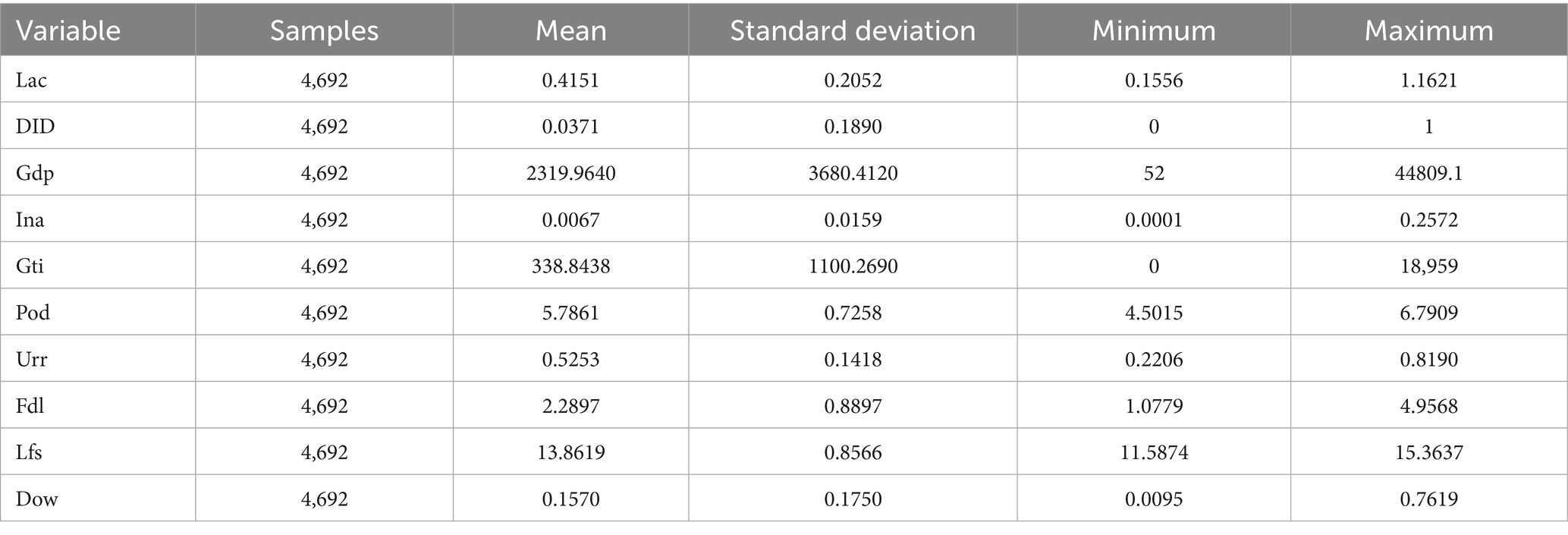
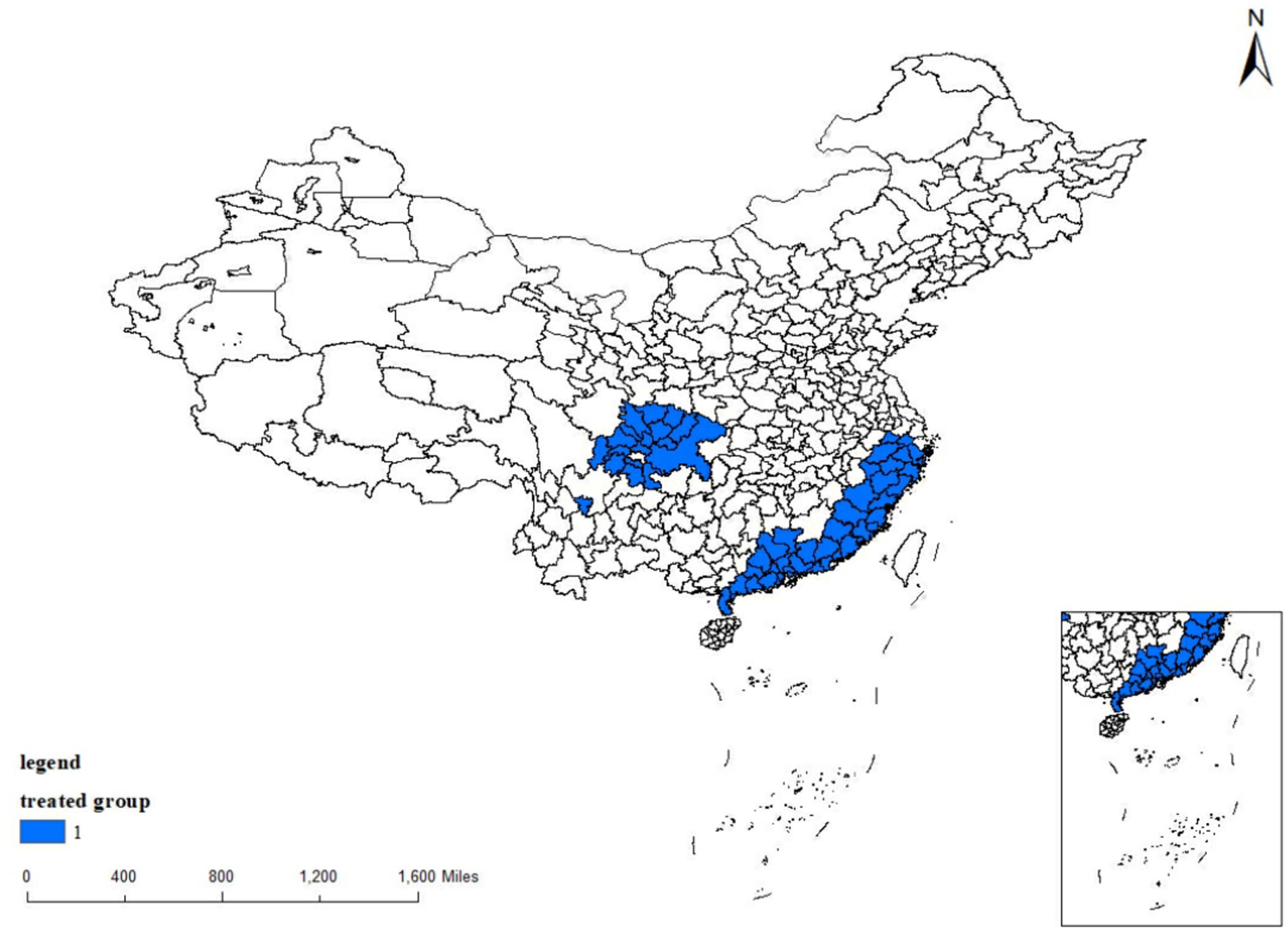
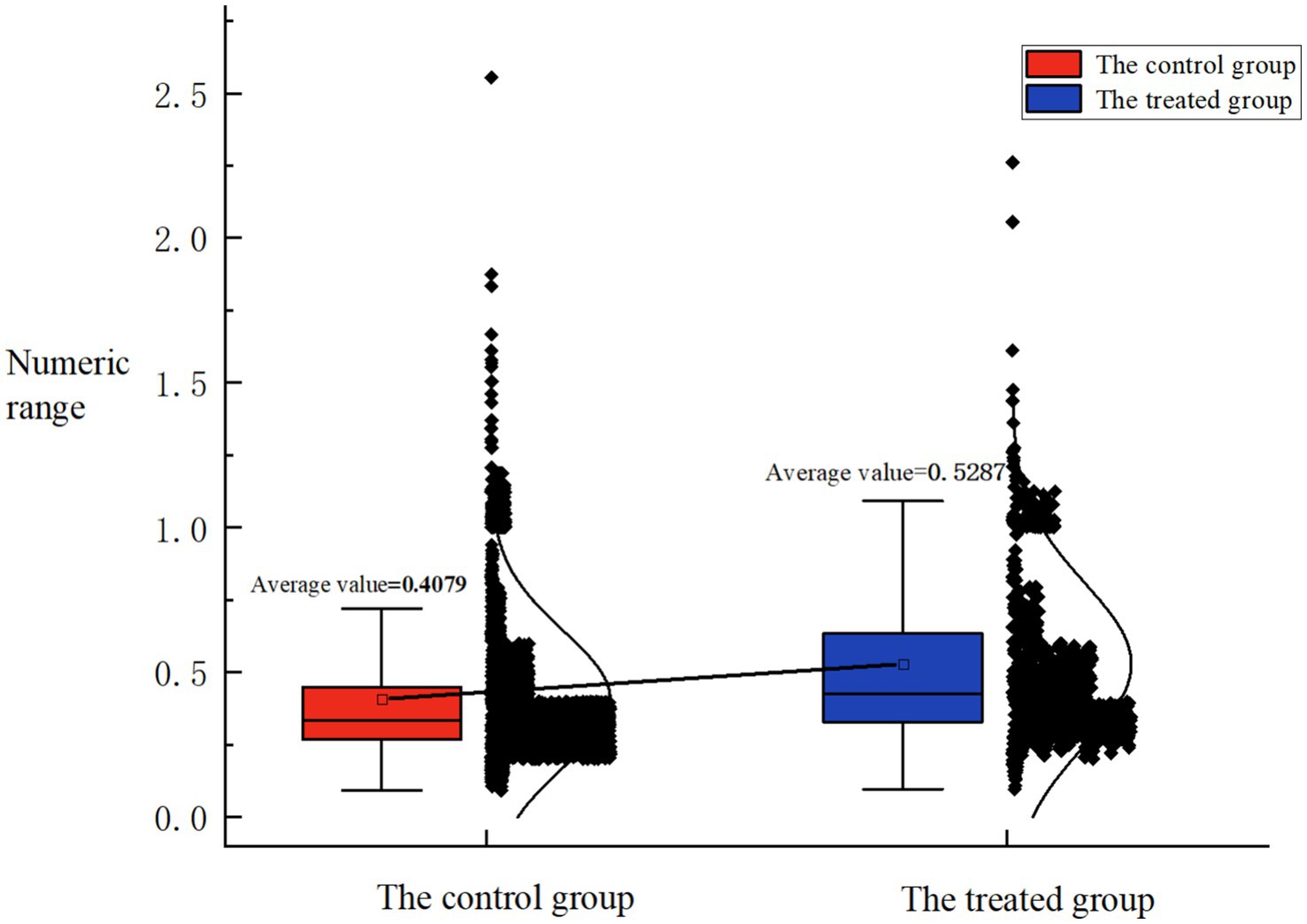

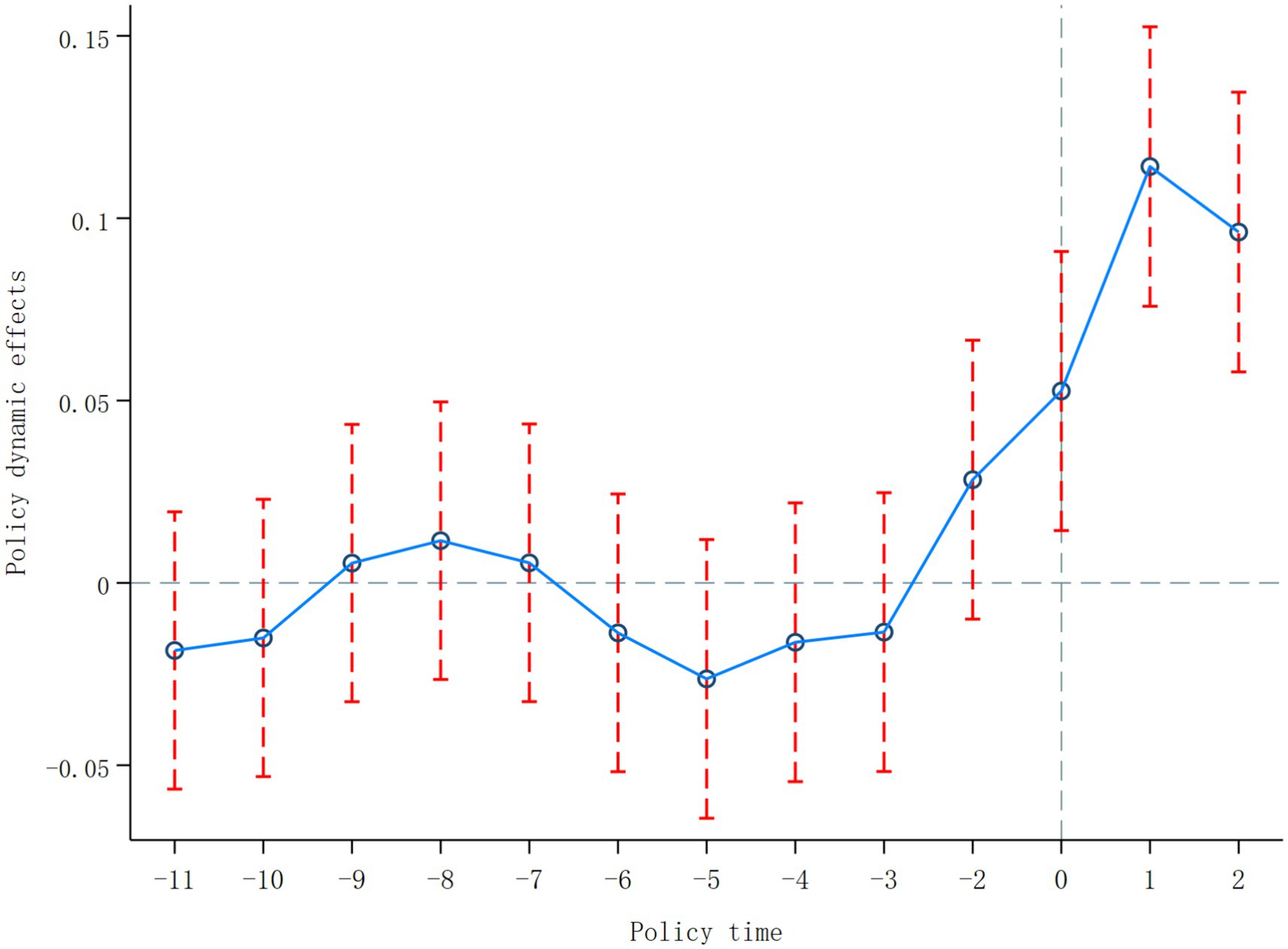
![Plot showing the relationship between \(p\_value\) and \(\_b[DID]\). Blue dots represent \(p\_value\), and the red line represents kernel density estimation for beta. The x-axis is labeled \(\_b[DID]\), and the y-axes are labeled for \(p\_value \) and \(kdensity\, beta\). A dotted line indicates the real estimated value.](https://www.frontiersin.org/files/Articles/1676352/fsufs-09-1676352-HTML/image_m/fsufs-09-1676352-g005.jpg)
